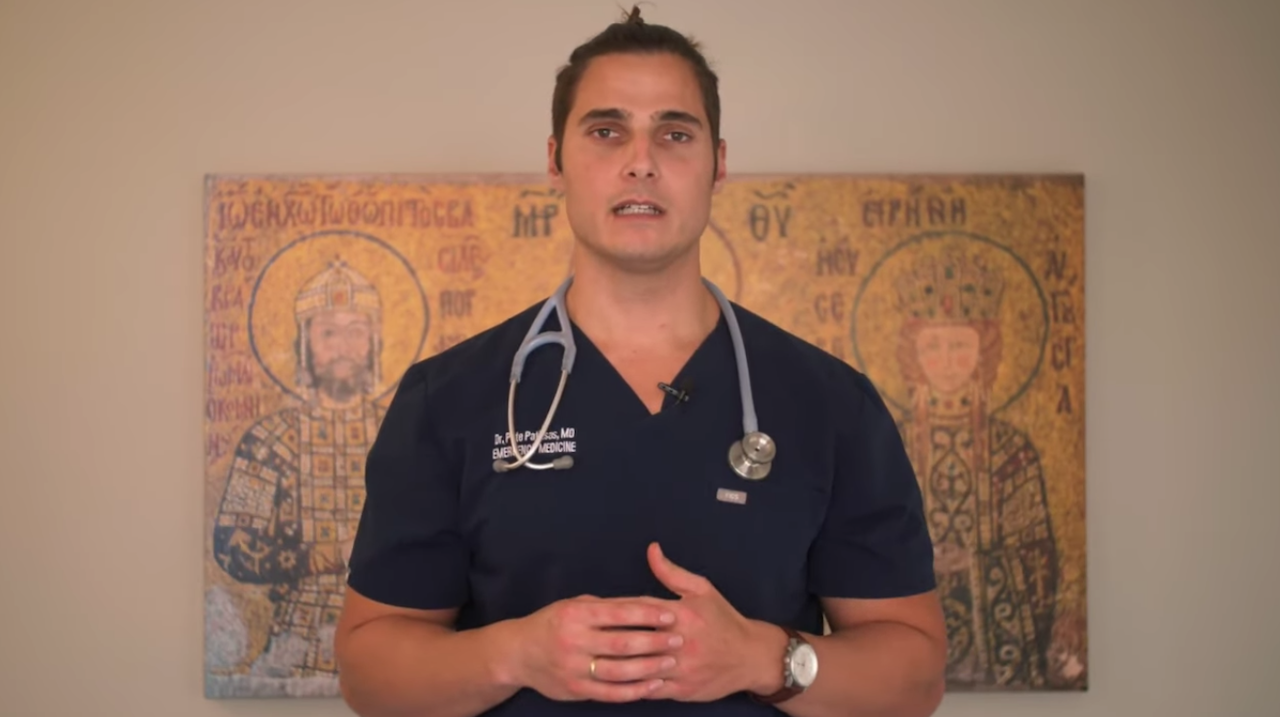
Greek-American Pete Patitsas, an emergency medicine doctor, looked to the monks of Greece’s Mount Athos for inspiration and direction in his book on diet and healthy living.
The Athos Diet: Before There Was Atkins, There Was Athos, establishes what Patitsas calls three pillars: intermittent fasting, a high protein (plant-preferred) diet, and walking for at least thirty minutes a day.
That’s essentially what the monks of Mount Athos follow, those three pillars that are “largely responsible for them outliving the rest of the world for the last thousand years,” Patitsas said.
Since Greek Orthodox monks at Athos are not allowed any meat, they subsist mainly on legumes and vegetables while they are able to consume fish on Orthodox holidays.
The health benefits of that kind of diet have been studied and proven, Patitsas said. Studies also show that alternating between fasting and non-fasting foods allows the entire body to rest and absorb all the nutrients.
Diseases Rare Among Monks of Mount Athos
Diseases that are associated with excesses of ordinary diets are also rare on Mount Athos —or “Holy Mountain.” Intestinal or stomach cancers are very rare among the monks while heart diseases and strokes are even less common.
From a doctor’s perspective, “there’s massive return on investment for these three [pillars],” said Patitsas, a married father of four who lives with his family in Pennsylvania. Patitsas, 37, spoke to Greek Reporter on Thursday while vacationing in Poland. The book’s editor, MB Gayle, shares an author credit.
The Athos Diet stemmed from a 2017 research project Patitsas completed in medical school on the science of intermittent fasting. As a practicing doctor, he treats patients for 21st century ailments like obesity, cardiovascular disease, and hypertension. Patitsas said he’s been doing some form of fasting since he was seven, as a result of being Greek Orthodox.
For his book, he looked for an approach that could help people stay out of the hospital and the emergency department. “I [started] looking within my own heritage and background,” he said. “The Greeks gave the world a lot of stuff, including medicine and philosophy.”
Mount Athos itself is home to twenty monasteries under the direct jurisdiction of the Ecumenical Patriarch of Constantinople, governed as an autonomous state within the Greek Republic.
The first monks arrived on Mt. Athos in the ninth century. Today, over two thousand monks from Greece and many other countries, including Romania, Moldova, Georgia, Bulgaria, Serbia, Russia, and the United States, live an ascetic life on Athos, isolated from the rest of the world.
There is a prohibition on entry for women, called avaton in Greek, to make living in celibacy easier for the men who have chosen to do so. Patitsas said while the historical example of the “Athos Diet” is unique to men on Mount Athos, scientific literature makes no distinction between genders in terms of how effective it is.
While encouraging a long-term, healthy lifestyle, Patitsas’ book does dangle a fairly ambitious short-term goal. The Athos Diet itself is a 48-day fast, mimicking the period of Lent in the leadup to Easter in the Greek Church.
Someone who follows the three pillars, which includes shortening the eating window to between four and eight hours a day, could lose up to ten percent of his or her body weight, Patitsas believes. The author also follows his diet, he said, and doesn’t eat during his shift in the ER.
A book not related to Patitsas’ work, The Mount Athos Diet: The Mediterranean Plan to Lose Weight, Feel Younger and Live Longer, was published in 2015.
Patitsas said previous studies he reviewed have highlighted what and how much the monks of Mount Athos eat but not when they eat. Greek scientists, professors, and doctors have gone to Mount Athos to figure out why the monks are living so long, he said, and why they have such low rates of cardiovascular disease, stroke, and heart attack.
“The quality of the food they eat makes a big difference,” Patitsas said. But, he added, “here’s a population that interestingly is also doing [intermittent fasting].” Both are advantageous, he said, but “something that can’t be overlooked is when they eat as well.”
And while the plant-heavy Mediterranean diet is regarded among the overall healthiest for humans and for the planet, it does include small amounts of red meat and moderate amounts of poultry and fish. The monks of Mount Athos abstain from red meat and poultry.
Patitsas visited Mount Athos for the first time as a teenager, calling it “an extraordinary place.” He is Greek Orthodox and says there are many adherents whose fasting practices are unhealthy because they load up on sugars and white bread.
Health Crisis
Patitsas said the United States is in a health care crisis, which is one of the main reasons he wrote the book. Greece, meanwhile is not an exception. The childhood obesity rate in Greece is one of the highest in Europe, as 41 percent of children aged 10 to 12 in Greece are overweight or obese. In March, scientists told a Greek Parliament standing committee that over 38 percent of the country’s population is overweight and 32 percent are obese while 21 percent of children under the age of nine are overweight or obese.
Patitsas was born and raised in central Pennsylvania to Greek parents who were themselves born in the United States. His family comes from the Greek island of Lefkada in the Ionian Sea, which he has visited and where he is planning to return this month.
“I feel like this diet is relevant to our Greek heritage,” he said, “and a region of Greece that is special to the world.”
See all the latest news from Greece and the world at Greekreporter.com. Contact our newsroom to report an update or send your story, photos and videos. Follow GR on Google News and subscribe here to our daily email!



